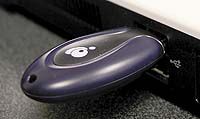| A bluetooth dongle has been inserted into a free USB port on a notebook computer. Bluetooth dongles, which are very inexpensive, add bluetooth wireless functionality to computers. |
Legend has it that King Harold “Bluetooth” Blattand, who ruled Denmark during the latter part of the 10th century, was so fond of blueberries that his teeth were stained blue. Others claim he had a dark, almost blue complexion.
No one really knows for sure where the king got his unusual nickname. In any event, Ericcson, a Swedish company, chose to name their new wireless technology in his honor and called it “Bluetooth” – a rough English interpretation of the word “blattand.” For the logo, they chose to merge two characters from the ancient runic alphabet.
Naming the technology after King Harold, who is best known for uniting Denmark and Norway, is very fitting considering that Bluetooth is a wireless technology designed to join devices together and allow them to communicate with one another.
Even though Bluetooth is still not fully mainstream in Carbon and Emery counties, it has actually been around for some time. Ericcson unveiled the new wireless technology with its interestingly odd name in 1994.
Later, in 1998, the Bluetooth Special Interest Group (SIG) was formed by several major technology companies to promote widespread adoption of Bluetooth. And by the year 2000 dozens of companies had joined the crusade and pledged to support it.
Although Bluetooth is a wireless technology, it is not a competitor to Wi-Fi. Bluetooth serves a very different purpose. Where Wi-Fi allows computers to talk to other computer networks (like the Internet, for example), Bluetooth allows a myriad of devices to communicate with each other. It does this by pairing one device with another.
For example, Bluetooth can connect headphones to portable media players. It can connect headsets to cell phones. It can even connect PDAs to notebook computers. It does all of this without wires.
Once paired, the devices become what is called a “PAN” – a personal area network.
Once two ore more devices are connected, Bluetooth can be used for a number of things. Music can be transmitted to headphones, address books can be synced between PDAs and computers, files can be transferred between devices and so on. The sky is the limit.
But not all Bluetooth-enabled devices have all the same capabilities. Many cell phone providers, for example, have removed the ability to transfer files to the phone via Bluetooth to discourage people from making their own ring tones. The documentation that came with the device should explain exactly what Bluetooth features are available.
Pairing Bluetooth devices often requires that one of them is put into “discovery mode.” The one device then detects the other and attempts to connect. The user may then need to provide a pin number or password to complete the connection.
Compared to other wireless technologies, Bluetooth (approximately 2-3 megabits-per-second, or Mbps) is just slightly faster than infrared (less than 1 Mbps), but far slower than Wi-Fi – even slower than the aging “B” specification (formally called “IEEE 802.11b”), which operates at a speed of 11 Mbps.
Bluetooth is even a far cry from faster wireless networking speeds like “G” (“IEEE 802.11g”), which operates at 54 Mbps, or the recently debuted “N” (“IEEE 802.11n”), which operates at a blazing speed of 100 Mbps.
Bluetooth also has a much shorter transmission range than Wi-Fi at less than 30 feet. Wi-Fi devices, in contrast, can often communicate at distances of over several hundred feet, and in some cases even several hundred yards.
There are a number of reasons Bluetooth was designed to operate at such a short range. First, shorter ranges mean less interference with other Bluetooth devices. Second, shorter ranges also help prevent security breaches or data theft. But most importantly, shorter transmission ranges help preserve battery life. This is very important since most Bluetooth devices are in fact battery powered.
But short transmission ranges aren’t the only security mechanism that Bluetooth employs. Device to device encryption is used to keep transmissions private. This is a very important feature to have when in densely populated areas like airports, malls or even at community events.
Unfortunately, security experts have shown there are some fairly serious flaws in the way Bluetooth devices negotiate encryption, especially in older devices. Newer Bluetooth standards should help alleviate these problems, however.
To further battery life and prevent security attacks, many security experts still suggest turning off Bluetooth features when they are not in use, especially on cell phones or other devices that are carried virtually everywhere.
And most importantly, consumers should check the documentation that came with their Bluetooth enabled devices so they know exactly how the Bluetooth features work.
Have comments about this article, or suggestions for an additional Tech Tips article? Send an e-mail to webmaster@sunad.com.

